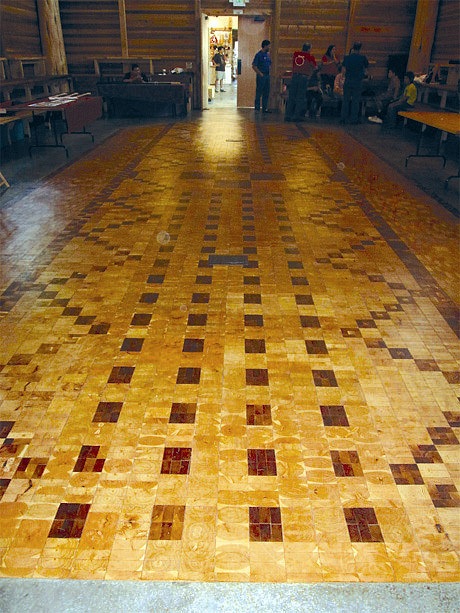The presence of the Duwamish in the Puget Sound region dates back thousands of years. In 1851, when the first European-American settlers entered the scene, around 90 Duwamish longhouse structures dotted the shores of Elliott Bay. The newcomers received a warm welcome from Chief Si’ahl’s (Seattle). The Dkhw’Duw’Absh (Duwamish), the “People of the Inside,” canoed the settlers around the region, showed them the nutrient-rich nectar of clams and shared their best berry fields.
Over a century and a half later, I step inside the brand new Duwamish Longhouse and Cultural Center on W. Marginal Way to a warm welcome.
“How can I be of service?” says James Rasmussen, Tribal Council member and longhouse director. He has gray eyes and a long, graying ponytail. Drums and singing spill from the next room. “Our dance group is holding practice. You’re welcome to go on in. We’re very proud of our kids.”
“Is there an admission?”
“It’s free.” Rasmussen gestures to a glass jar on the gift shop counter, labeled Legal Defense Fund. “You’re always welcome to make a donation.”
I inhale the scent of fresh-hewn cedar, glad to finally be visiting the longhouse, which opened in January of this year. It gives the impression of being built to last — structural posts the size of old growth trees; lustrous, solid wood; everything suffused with natural lighting.
Definitely not the kind of structure that pops up overnight. Based on a 1976 survey, under the leadership of Tribal Chair Cecile Hansen (grand-niece of Chief Seattle, she is still the chairperson today), during a time of struggles for federal recognition that continues unresolved, the Duwamish people began to dream of creating a focal point for their dispersed community. Over time, the idea for a longhouse and cultural center took shape.
“Our architect, Byron Barnes, a Blackfoot, was in meetings with us for 25 years,” Rasmussen says. In 2004, the Duwamish were finally able to afford a small parcel on W. Marginal Way. Five years later, the new Longhouse and Cultural Center opened its doors. “The whole thing came together as, basically, what the tribe’s vision was and what we could actually do.”
City fire codes do not permit fire pits, a traditional feature of longhouses. Nonetheless, the new structure has a sense of authentic history and hope for the future.
The open room as you enter is a combined Duwamish museum, Native art gallery and gift shop. Large picture windows along W. Marginal Way face “Herring House” Park across the street, land that was once an ancient Duwamish village. Arrowheads dating to 300 B.C., displayed in a case in the museum, came from a historic site nearby. “Herring House” Park, situated along the Duwamish River, is now one of several Habitat Restoration sites. Native plants, fish and wildlife are gradually returning.
The room to the right, where the dancers are practicing, is the Salish cedar longhouse. The inside walls of the open room feature sturdy cedar benches where, traditionally, people would have slept.
The Tilibsedeb (“Singing Feet”) dance group members, done for the day, have now gathered on the benches in one corner. Leader Mike Evans is closing the session. “When you enter the dance floor, we want you to honor the presence of the Spirit,” he says.
The dance floor. Yes. A stunning feature, an intricate mosaic of cedar tiles designed by Mary Lou Slaughter, Duwamish Basket Weaver and direct descendant of Chief Seattle.
“The dance floor tells the story of the tribe and of the longhouse,” Rasmussen says.
Along the walls of the longhouse, a traditional canoe, cedar bark clothing and a blanket are among the displays. This room is not only where tribal business, educational events and workshops are held; it is also open to the public and available for events rental.
For more information: http://duwamishtribe.org/longhouse.html.
Islander Claire Gebben can be reached at clairegebben@gmail.com.




